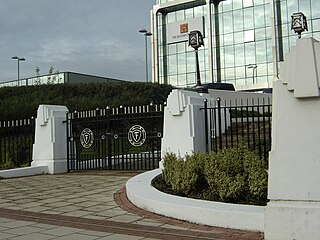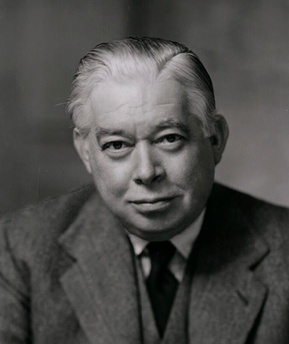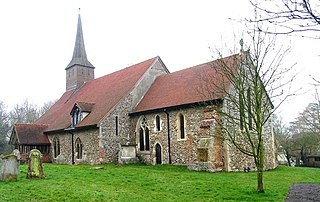
Rayne is a village of about 2,300 residents in the Braintree district of Essex in the East of England.

Witham is a town in the county of Essex in the East of England, with a population of 25,353. It is part of the District of Braintree and is twinned with the town of Waldbröl, Germany. Witham stands between the city of Chelmsford and the City of Colchester, on the Roman road between the two. The River Brain runs through the town and joins the River Blackwater just outside.

Foots Cray is an area of South East London, England, within the London Borough of Bexley. Prior to 1965 it was in the historic county of Kent. It is located south-east of Sidcup, north of Orpington and north west of Swanley.

The Golden Mile is a stretch of the Great West Road north of Brentford running west from the western boundary of Chiswick in London, United Kingdom.

The Hoover Building is a Grade II* listed building of Art Deco architecture designed by Wallis, Gilbert and Partners located in Perivale in the London Borough of Ealing. The site opened in 1933 as the UK headquarters, manufacturing plant and repairs centre for The Hoover Company. The building is now owned by IDM Properties and has been converted into apartments.

Thomas Smith Tait was a Scottish modernist architect. He designed a number of buildings around the world in Art Deco and Streamline Moderne styles, notably St. Andrew's House on Calton Hill, Edinburgh, and the pylons for Sydney Harbour Bridge.

Braintree Town Football Club is a semi-professional football club based in Braintree, Essex, England. They are currently members of the National League South, the sixth tier of English football, and play at Cressing Road.

Witham Town Football Club is a semi professional English football club based in Witham, Essex. The club are currently members of the Isthmian League North Division and play at the Simarco Stadium.

Valentine George Crittall, 1st Baron Braintree, was a British politician and businessman who served briefly as a Labour Member of Parliament before later joining the Conservatives.

White Notley is a parish in Essex, England. The settlement lies equidistant between the towns of Witham and Braintree amongst arable farmland, 4 miles (6.4 km) in each direction. White Notley is a quintessentially English village with a small primary school, public house, railway station, post office, village hall and a 10th-century church. The village has a population of fewer than five hundred inhabitants, but at the 2011 Census the population of the civil parish was measured at 522. Railway service is provided at the White Notley railway station on the Braintree Branch Line. It forms part of the Parliamentary Constituency of Witham.
Silver End is a village in Braintree, Essex, in England. It was conceived as a model village by the industrialist Francis Henry Crittall who established a Crittall Windows Ltd factory there to manufacture components for metal windows.

Cressing railway station is on the Braintree Branch Line in the East of England, serving the villages of Cressing and Black Notley, Essex. It is 42 miles 75 chains (69.10 km) down the line from London Liverpool Street via Witham and it is situated between White Notley to the south and Braintree Freeport to the north. Its three-letter station code is CES. The platform has an operational length for nine-coach trains.

Metals used for architectural purposes include lead, for water pipes, roofing, and windows; tin, formed into tinplate; zinc, copper and aluminium, in a range of applications including roofing and decoration; and iron, which has structural and other uses in the form of cast iron or wrought iron, or made into steel. Metal alloys used in building include bronze ; brass ; monel metal and nickel silver, mainly consisting of nickel and copper; and stainless steel, with important components of nickel and chromium.

Braintree is a town in Essex, England. The principal settlement of Braintree District, it is located 10 miles northeast of Chelmsford, 35 miles (56 km) northwest of Southend-on-Sea, and 15 mi (24 km) west of Colchester. According to the 2021 Census, the town had a population of 43,492, while the urban area, which includes Great Notley, Rayne, Tye Green and High Garrett, had a population of 55,792.
Cressing Road, also known as the Rare Breed Meat Co. Stadium for sponsorship purposes, is a football stadium in Braintree, Essex, and the home ground of Braintree Town, and formally their reserve side. It currently has a capacity of 4,222.
Francis Henry Crittall (1860–1935) was an English businessman and philanthropist who in 1884 in the Essex town of Braintree instigated the manufacture of metal-framed windows by the Crittall Manufacturing Company Ltd. This company, now known as Crittall Windows Ltd, became the world's leading manufacturer of steel-framed windows. Crittall also funded the development of the model village of Silver End in Essex.

Charles Henry Bourne Quennell (1872–1935), was an English architect, designer, illustrator and historian. According to the heritage architect Cath Layton, "his great influence [as an architect and urban planner] can be felt in the houses and streets of London’s suburbs and across the country." His obituary in Nature noted that his books for children and young people had "strongly stimulated interest in the cultural background of the more formal study of history".

Henry Hope & Sons Ltd were a major manufacturer of metal components, including steel and metal windows, roofing, gearing and decorative metal ironmongery based in Smethwick, West Midlands, UK. Founded in 1818 as Thomas Clark as Jones & Clark, in Lionel Street, Birmingham, they became known as "Henry Hope" in 1875 when Henry Hope, who had become a partner in 1864, became the sole owner. Early works included manufacturing glasshouses and other major orders included all the bronze windows for Barry's new Houses of Parliament, London, in 1845 - 57.

Astor Mansions is an Art Deco style building that was designed by architects Obel & Obel in 1931 and completed in 1932. The building was residential with street level retail and first floor professional office space. It was built to the maximum height of 140 feet permitted by the City Council. The building had a short lived stint as the tallest building in Johannesburg until the completion of the Ansteys Building in 1935.
Curran Steels was a manufacturing company in Cardiff, Wales, founded as the Edward Curran Engineering Co and known locally as Curran's.
















